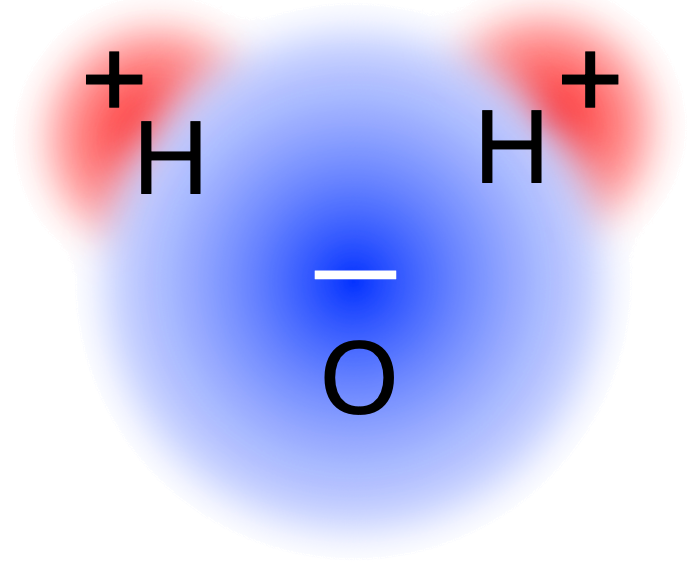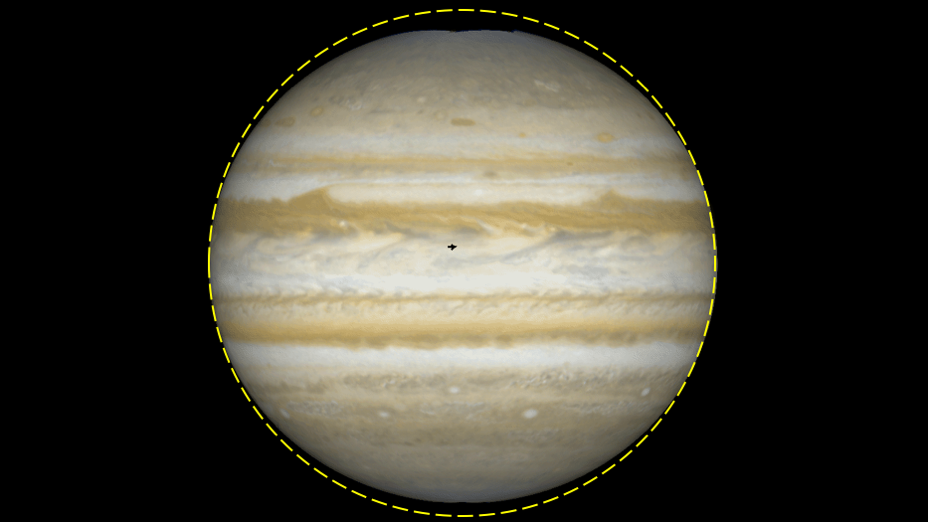The shape of water
- brianaull
- Feb 15
- 5 min read
Updated: Aug 8
A close look at water
Above is a water droplet on a dandelion seed, illuminated by light reflected from blue and yellow pieces of construction paper. (Click the picture to find out how and why the photographer did this.) Perched delicately on the seed, the water droplet contracts into a spherical shape and forms a tiny lens.
Why is the water droplet spherical? Its shape is a response to forces of attraction. Let's look at these forces, first at the level of molecules and then working our way up to the largest oceans.
Mickey Molecule

On the right is a picture of a water molecule, which is an oxygen atom bonded to two hydrogen atoms. Oxygen strongly attracts electrons, so it (partially) steals the electrons from the hydrogen atoms. So, the oxygen atom acquires a negative charge, leaving positive charges on the hydrogen atoms. Opposite charges attract, so when water molecules congregate, the oxygen on one molecule is attracted to a hydrogen on a nearby one.

This attraction gives rise to an unusual property: Water expands when it freezes. When water freezes it forms a regular structure of hexagons with open spaces. When it liquifies, the molecules move around and collide, so these open spaces don't have a chance to form. The molecules jostle closer together. The lower density of ice causes it to float. If ice sank, the Earth would be a less hospitable place for life.
This attraction also creates what we call surface tension.
Surface tension

A water bug can walk on a pond. This is not from any divine power, but rather from a force called surface tension. The surface of the water resists a change in shape that will increase its surface area. For the water bug, that resistance is strong enough to support its weight.
Surface tension causes the water droplet to become spherical because this is the shape that has the smallest surface area. Where does this force come from? The attraction between the water molecules causes them to seek to be surrounded on all sides with other water molecules. Any molecule that ends up at the surface is incompletely surrounded. So the attractive forces will minimize the number of molecules that end up in this situation, which in turn minimizes the surface area. In other words, to deform the droplet into a non-spherical shape, you need to pry apart water molecules that are attracted to each other.
The water bug's pond does not ball up into a sphere because, for macroscopic bodies of water, gravitational forces will cause the water to "hug" the Earth's surface. Let's look at what happens when gravity acts in combination with centrifugal forces.
The spinning tank
When a thin tank of water is spinning on a turntable, centrifugal force causes the water to flow away from the center. When the flow stops, the water surface has a parabolic shape as shown on the right. The flow stops when the surface of the water has the right shape to create balance between gravity, which pulls the water downhill toward the center, and the centrifugal force, which pushes it uphill away from the center. As one moves away from the center, the centrifugal force gets stronger. To balance this, the hill gets steeper.

Here's a picture of the two forces acting on a little boat. They combine to produce a net force that is neither uphill nor downhill, that is, it's perpendicular to the water surface. Even though the water surface is curved, it is everywhere level in terms of this force balance. If a boat passenger placed a ball on the deck, it would not roll toward either bow or stern.
If this balance did not prevail, there would be a net uphill or downhill force on the water itself. This would cause the water to flow until the balance is restored.
Planet-sized water drop
Imagine a non-spinning planet consisting completely of water.. Now the dominant force is gravitational attraction among large volumes of water. Each "piece" of water will seek to be surrounded on all sides with other "pieces," drawing the planet into a shape of minimum surface area, namely a sphere. Deforming the planet into a non-spherical shape would require prying apart volumes of water that are attracted to each other. If one scooped out a valley and piled that water somewhere else to make a hill, the water would flow to fill in the valley and annihilate the hill, restoring the spherical shape.

Also, a boat would experience a gravitational force that is everywhere perpendicular to the water's surface. The surface would be everywhere level in terms of the rolling ball test.
Planetary body shaming
Suppose that the water planet spins on an axis through its poles. This will create a centrifugal force, which gets stronger as one moves away from the axis. This force causes the water to flow away from the poles towards the equator. The planet will become fat around the middle. The flow will stop when the water surface becomes level, that is when the net force (gravity + centrifugal) is everywhere perpendicular to the water surface. Here's what the gravitational forces look like in the northern hemisphere.

The force of gravity at the North Pole is stronger than at the equator because the North Pole is closer to the center of the planet. Also, except at the poles and at the equator, the gravitational force does not point exactly toward the center.
We can look at a boat in the northern hemisphere and see the force balance. Gravity is not perpendicular to the surface. Acting alone, it would cause the boat to sail northward. Acting alone, the centrifugal force would cause the boat to sail southward. These influences cancel. The net force is downward, that is, perpendicular to the water surface. Again, a ball on the deck will not roll. The water has "leveled" itself to achieve this balance.

Real planets
Earth's equatorial bulge is very slight, only 13 miles. As discussed in my post Living on a Spinning Planet, the centrifugal force is weak, only 0.3% of body weight at the equator.
Jupiter spins much faster. The centrifugal force at the equator is over 60 times stronger than on the Earth. One can detect the equatorial bulge in photos such as the one below.
Even solid planets acquire these ellipsoidal shapes. For something as large as a planet, the gravitational and centrifugal forces are strong enough to cause layers of rock to slide past each other, creating a flow. Small bodies, such as the moons of Mars, are not large enough for this to happen, so they have irregular shapes.






Comments